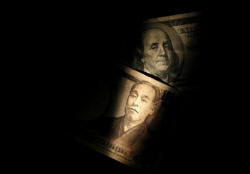|
Dollar at four-week highs
vs yen before Friday jobs report
 Send a link to a friend
Send a link to a friend
 [October 06, 2016]
By Patrick Graham [October 06, 2016]
By Patrick Graham
LONDON
(Reuters) - The dollar ground higher on Thursday, extending this week's
four-week highs against the yen before a jobs report many expect to help
seal the case for a rise in U.S. interest rates in December.
Rises in U.S. Treasury yields over the past 10 days have been the main
driver of a halt in the yen's steady progress this year, pushing the
Japanese currency back from 100 yen per dollar to 103.77 <JPY=> on
Thursday.
The yen was also within sight of Wednesday's five-week lows against the
euro, but in general moves across the major currencies were subdued.
"Obviously, the big focus is the U.S. jobs data tomorrow, so the market
is likely to be in wait-and-see mode today," said Alexandre Dolci, a
strategist with Spanish bank BBVA in London.
"If we do have this double-whammy of positive headlines from the U.S.
data tomorrow - a strong NFP (non-farm payrolls) number and a further
pick- up in average earnings - then we may see the dollar strengthen
into the end of the week."

The dollar index, which measures its broader strength against a basket
of currencies, rose 0.25 percent to 96.352. Against the euro it gained
just over 0.1 percent to $1.1189.
Analysts from Morgan Stanley argued that the fall in the yen was being
driven by a drop in hedging activity as U.S. yields rose.
"Over the course of the past few weeks, US front-end rates have moved
higher as the market prices in a 65 percent probability of the Fed
hiking rates by December," they said in a morning note.
"This repricing has primarily driven low-yielding currencies. The yen
has come under significant selling pressure, supported further by
foreigners net selling 1.89 trillion yen of Japanese money market
instruments."
Prime Minister Theresa May gave the pound - the big loser among the
major currencies in the past fortnight - a small bump on Wednesday by
warning of the negative side-effects of ultra-low interest rates.
[to top of second column] |

Light is cast on a U.S. one-hundred dollar bill next to a Japanese
10,000 yen note in this picture illustration shot February 28, 2013.
REUTERS/Shohei Miyano/Illustration/File Photo

But
signs that the government is ready to prioritise controls on immigration over
membership of the European Union's single market continue to dominate minds, and
it sank to another 31-year low of $1.2663 soon after the start of U.S. trade.
"My base case is that it is going to be extremely hard for the UK to escape
recession. The first two quarters of next year are going to be extremely
negative," said Davis Hall, Head of FX and Precious Metals at wealth manager
Indosuez in Geneva.
"Our ultra high net worth clients that have sterling, at these levels we are not
advising them to sell; the additional downside below $1.25 is limited. But we're
not expecting a massive recovery either, we have (forecast) $1.32 in six
months."
(Editing by Mark Trevelyan)
[© 2016 Thomson Reuters. All rights
reserved.] Copyright 2016 Reuters. All rights reserved. This material may not be published,
broadcast, rewritten or redistributed.

 |